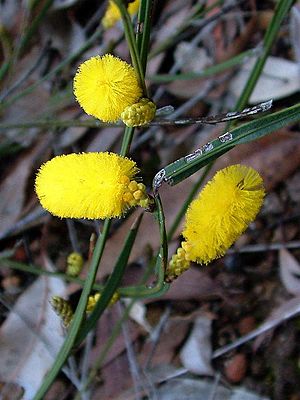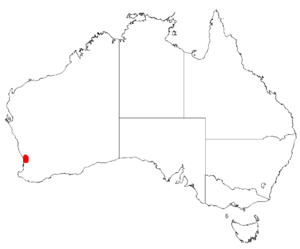Grass wattle facts for kids
Quick facts for kids Grass wattle |
|
|---|---|
 |
|
| Conservation status | |
| Scientific classification | |
| Genus: |
Acacia
|
| Species: |
anomala
|
 |
|
| Occurrence data from AVH | |
The Grass Wattle (scientific name: Acacia anomala) is a type of shrub. It belongs to the Acacia family, which includes many wattle plants. This special shrub grows only in a small part of Western Australia. It is considered a vulnerable species, meaning it needs protection to survive. Both Western Australian and Commonwealth laws protect it.
What the Grass Wattle Looks Like
This shrub is quite slender and looks a bit like a rush plant. It usually grows to be about 0.2 to 0.5 meters (less than 2 feet) tall. It has many stems coming from its base. The upper parts of its stems have narrow "wings."
The Grass Wattle has very few leaves, or sometimes none at all. What look like leaves are actually flattened stems called phyllodes. These are long and narrow, about 4 to 10 centimeters (1.5 to 4 inches) long. They are only 2 to 6 millimeters (less than 0.25 inches) wide.
The plant produces bright yellow flowers. You can usually see these flowers between August and September. The flowers grow in simple spikes, which are about 1 to 3 centimeters (less than 1.2 inches) long. These spikes sit on short stalks.
After the flowers, seed pods begin to form. These pods are long and thin, about 5 centimeters (2 inches) in length. They are only about 3 millimeters (0.1 inches) wide. Inside the pods, the seeds are small, about 2.5 millimeters (0.1 inches) long, and have an oblong shape.
About Its Name
The Grass Wattle was first officially described in 1978. This was done by a scientist named Arthur Bertram Court. He wrote about it in a science journal called Nuytsia.
For a short time in 2003, another scientist, Leslie Pedley, gave it a different name, Racosperma anomalum. But by 2006, it was changed back to its original name. The name was finally settled in 2011. You can learn more about this by looking up Acacia.
The first sample of this plant was collected in 1961. It was found by Charles Austin Gardner and H.H.Kretchmar. They found it between Muchea and Chittering. The Grass Wattle looks very similar to another plant called the Acacia applanata.
Where the Grass Wattle Grows
The Grass Wattle grows in a very small area. You can find it in Western Australia, between places like Chittering, Swan, and Kalamunda.
It likes to grow on the slopes of the Darling Range. It prefers a type of soil called lateritic soil. You will often find it growing among Eucalyptus trees in woodland areas.


